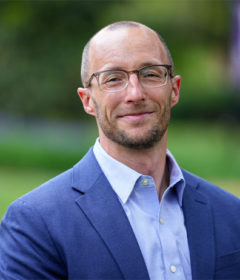‘Hitler’s Monsters’
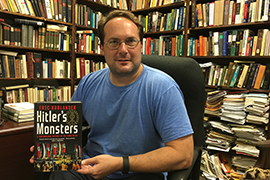
To many Nazis, the Aryan race descended from Nordic “God Men” who came straight down from Heaven and created the lost civilization of Atlantis.
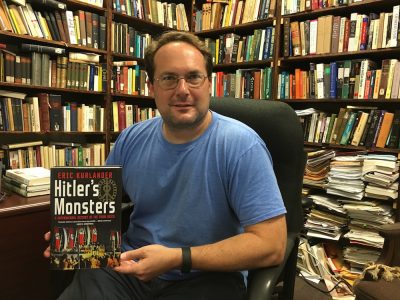
When Atlantis was destroyed by a flood, their ancestors fled to the Himalayan mountains and bred with Asians, eventually creating the great civilizations of the East, including the ruling caste of India and the ancient Japanese samurai.
These are some of the bizarre Nazi beliefs revealed in Stetson University history Professor Eric Kurlander’s latest book, “Hitler’s Monsters: A Supernatural History of the Third Reich,” released July 18, 2017, by Yale University Press.
This is Kurlander’s third book and follows up on “Living with Hitler: Liberal Democrats in the Third Reich,” published in 2009, and “The Price of Exclusion: Ethnicity, National Identity, and the Decline of German Liberalism, 1898-1933,” published in 2006.
Kurlander, Ph.D., spent eight years on his latest book and traveled to Germany several times to pour through hundreds of Nazi Party documents and other records in the German Federal Archives. “Hitler’s Monsters” is the first scholarly book to provide a comprehensive study of the Nazis’ obsession with the occult, Kurlander writes in the introduction.
The book details how top Nazi leaders, such as Heinrich Himmler and Joseph Goebbels, believed “scientific astrology” or utilized the prophecies of Nostradamus to create wartime propaganda. The Nazis relied on dowsers to locate enemy ships, forcing dowsers to hold pendulums over nautical charts with one-inch toy battleships, waiting for the pendulum to make the slightest movement and supposedly confirm an Allied battleship in that location. Hitler employed his own dowser to check his Reich Chancellery for harmful “death rays” and apparently read a book on “magic” written by a famous parapsychologist.
“The Darkest Heart of Nazi Germany”
Kurlander writes that Hitler also embraced World Ice Theory, a wacky “border science” that claimed icy moons had crashed into Earth, creating the floods that wiped out Atlantis. The Nazis even sent an official expedition to Tibet to try to find evidence that Aryans once lived in the Himalayas.
“It’s not that everything in the book is completely new, but many of these sources and stories have never seen the light of day. Certainly, no one has tried to bring all these stories together or corroborated them the way I have,” said Kurlander, who is proficient in German and reviewed the original historical documents.
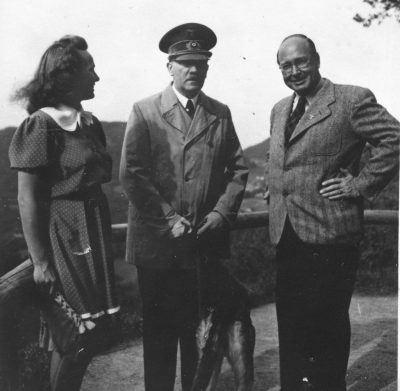
He continued, “The story has never been told the way the Nazis appropriated systematically esoteric, border scientific ideas, like magic, for the purposes of coming to power nor in their manipulating people after they were in power, of deploying their message or explaining their religious views, their views on race or their ideas of living space.”
Kurlander’s book details the Nazis’ “monstrous science,” their horrific human experiments on Jewish, Polish, Russian and German prisoners, and their “demonization and genocide” of the Jews – which led, as the Third Reich called it, to the “final solution” to the “Jewish question.”
Based on this mostly esoteric and mythological cosmology, the Nazis wanted to create a “Nordic ruling class” that would dominate the world. They sought to restore German racial and territorial superiority through theories of selective breeding drawn simultaneously from science and the supernatural, including obtaining more “living space” in eastern Europe, and “‘exterminating’ the Jewish ‘enemy race,’” whom they repeatedly compared to parasitic vampires, leading to the systematic murder of six million innocent Jewish civilians.
As the book jacket says, Hitler’s Monsters “delves deep into the darkest heart of Nazi Germany.”
Kurlander traces the Nazi leaders’ fixation on “Aryan Europe’s” pagan roots, including witchcraft and Luciferianism (or Satanism). If they won the Second World War, some even intended to eliminate Christianity, a fact they hid from the German people because they feared they would lose popular support.
Some of the stories are so bizarre that Kurlander, who received his master’s degree and doctorate at Harvard University, worried whether other scholars would initially take them seriously. So, he went a bit “overboard” and provided 105 pages of footnotes and sources in the book, he said during an interview in his office in Elizabeth Hall.
“When you’re talking about Hitler’s Monsters and the occult, there’s obviously a lot of fluff and, as I argue in the introduction, a lot of non-serious work out there – comic books, popular crypto-history, what have you – so without sufficient empirical basis, I was very worried about whether my arguments would be plausible.
“So I think I went overboard in some way, like I made sure I cited copious evidence for most of my main points in ways that I might not have felt as great a due diligence as I would have with a more conventional topic,” he explained.
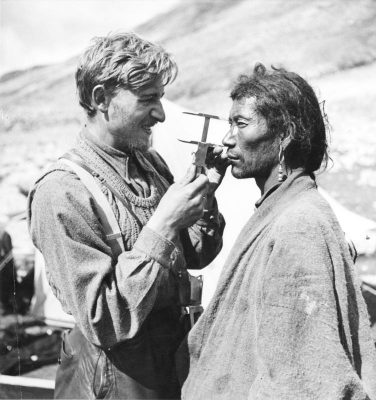
The research was time-consuming and required several trips to Germany. In the book’s acknowledgements, he credits four Stetson University Summer Research Grants (in 2009, 2012, 2013 and 2015) and a Spring 2015 Stetson Sabbatical Award for making the book possible, as well as a 2012 Fulbright Scholar Fellowship and a 2012 teaching exchange with Stetson’s partner university in Freiburg. He also thanks colleagues, administrative assistants, work-study students and student research assistants at Stetson for helping with the project.
“For my last two books, the preliminary research and some of the follow-up research was done in the summer, usually with the help of a Stetson Summer Research Grant. I want to both give credit to them for providing a lot of the initial research and also point out how much we could use more funding,” he said, adding that fellow Stetson history Professor Mayhill Fowler, for example, also traveled to Ukraine on a Stetson summer grant for archival research for her recent book, “Beau Monde on Empire’s Edge: State and Stage in Soviet Ukraine.”
“This archival research is so intrinsic to what we do,” he added. “Those grants are essential and we hope that fund can keep growing.”
Good Reviews
“Hitler’s Monsters” already is receiving good reviews in the international media.
A reviewer for The Spectator in Britain lauded the book, writing: “Deeply researched, convincingly authenticated, this extraordinary study of the magical and supernatural at the highest levels of Nazi Germany will astonish — and provide scholars and the general reader with much food for thought.”
Another reviewer with The Times of London wrote that he was surprised to learn top Nazi leader Himmler “was an old hippy,” studying herbalism and believing yoga released cosmic energy. “Though this may all seem funny in some ways, the place that Kurlander finishes up in is anything but,” the Times reviewer wrote, referring to the genocide of Jews.
Kurlander already is planning to delve deeper into the darkest chapter of Nazi history in his next book, tentatively titled “Before the Final Solution: The Nazi-Jewish Question in Global Context.” He said the book will explore the Nazi “question of what do we do with the Jews historically; what are the solutions to that question before 1941.”

Kurlander’s focus on German and Central European history dates back to his undergraduate years at Bowdoin College in Maine, a private liberal arts school, where he majored in history. His favorite professor specialized in German history and Kurlander wrote his senior thesis on the Holocaust.
Afterward, he was accepted into Harvard for graduate work, where his advisor, David Blackbourn, was a 19th century German historian. (“David Blackbourn is one of the most important people in our field in the last 30 years,” Kurlander explained.) But studying at Harvard meant Kurlander would focus his graduate work on Germany from the 1890s into the 1920s, before the Third Reich.
“I recognized that by choosing Harvard, I’d have to branch back to an earlier period.…So my dissertation is on liberals between the 1890s and 1930s, which is my first book and has nothing really directly to do with the Third Reich,” he said.
But when he finished that book, he wondered what became of these liberals once Hitler seized power, and that became the subject of his second book, “Living with Hitler: Liberal Democrats in the Third Reich.” As he researched the Nazi era for his second book, “it wasn’t such a leap to say I’ve always been interested in the supernatural,” which led to “Hitler’s Monsters,” he said.
His third book serves as a warning of the “persistence and potential dangers” of supernatural thinking, especially in times of crisis, he writes in the book. Germany was devastated after World War I, resentful about being “colonized” under the Versailles Treaty, and struggling economically during the Great Depression. The Third Reich found it easy to manipulate mass culture with the supernatural.
“It can be harmless if it’s a bunch of people trying to raise spirits in their drawing room,” Kurlander added, “but when those become policies or ways of thinking, that’s when it becomes dangerous.”
-Cory Lancaster


